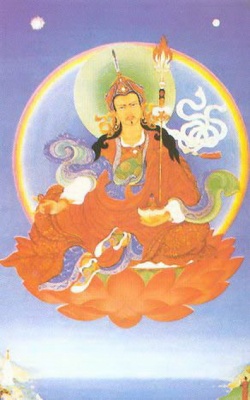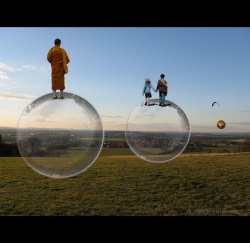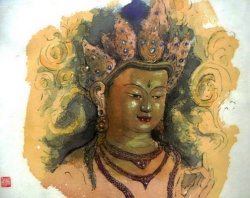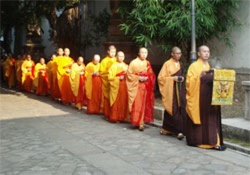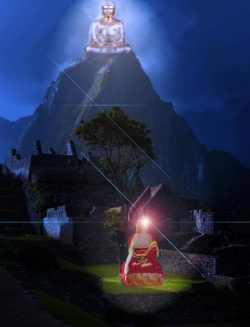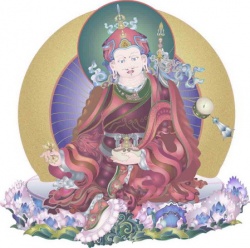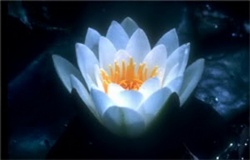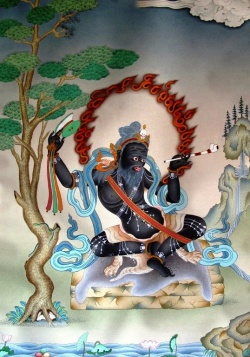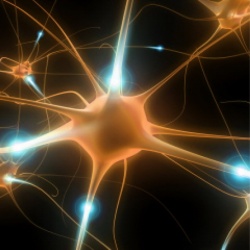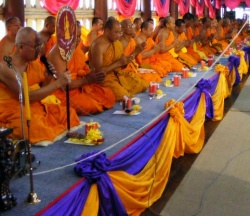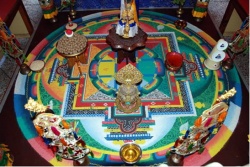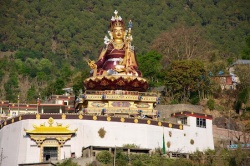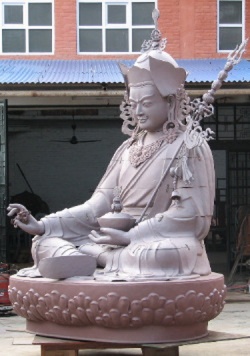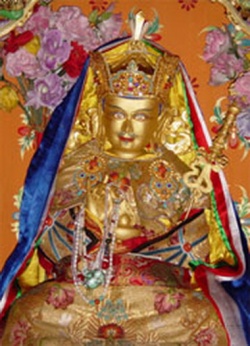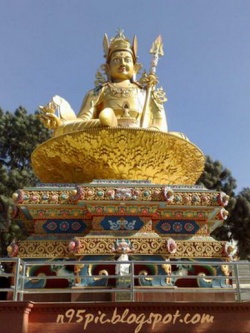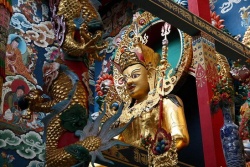The Nyingma Tradition
The Nyingma Tradition originates from Buddha Padmasambhava, who came to Tibet in the year 763 AD at the request of Chögyal Trisong Détsen (742-797). Padmasambhava bound the demonic influences of Tibet under oath as Protectors of Dharma.
Padmasambhava—in collaboration with Shantarakshita and Trisong Détsen—built Samyé monastery, which became a principal centre of learning and the site where many of the texts that would make up Tibet’s vast Buddhist literature were first translated into Tibetan.
Other teachers who came to Tibet in the First Spread of Dharma were Dri’mèd Shényèn (Dri med bShes gNyen – Vimalamitra), Sang-gyé Sangwa (rSangs rGyas gSang ba – Buddhaguhya), Lopön Shan-ti pa (sLob dPon Shan ti pa) and Drüpthob Chö-grak (Grub thob Chos grags – Dharmakirti).
The translation of the Kunjè Gyalpo (Kun byed rGyal po) the mDo Gog’du (mDo dGogs ’dus) and the Gyü-ma Chenpo (sGyu ma chen po – Mahamaya) was conducted by many highly trained translators such as Nam-nang, Nyag Yeshé Zhön-nu (gZhon nu – Jnana Kumara), and Nubchen Sang-gyé Yeshé.
Padmasambhava gave widespread teachings of the three Inner Tantras to Yeshé Tsogyel and to his twenty-five principal disciples.
These first Tibetan siddhas are renowned for their spiritual accomplishments.
Yeshé Tsogyel (mKha’ ’gro chen mo Ye shes mTsho rGyal) received every transmission and teaching Padmasambhava gave – and mastered everything without exception.
She became the living embodiment of Padmasambhava’s lineage in Tibet.
Through her Siddhis she could bring the dead back to Life and rescue beings from the lower realms.
Her memory was unfailing, and it was she who transcribed every word of teaching which Padmasambhava uttered and codified them into khandro-cypher to be discovered as gTérmas in future generations.
After Padmasambhava’s departure from Tibet, she encoded further gTérmas, both as texts and as Mind-mandate transmission.
Together with Nubchen Sang-gyé Yeshé she transcribed many more volumes of Padmasambhava’s teaching.
One of these texts is the famous Pema Thang-yig (pad ma thang yig) which details the Life of Padmasambhava. She spent the rest of her Life wandering throughout Tibet and the Himalayan regions, teaching many thousands of ngak’phang disciples.
She lived for a further two hundred years giving Empowerment and transmission to countless disciples.
Ngadag Ngakgyal Tri-song Dé-tsen (mNga bDag sNgags rGyal Khri srong lDe’u bTsan 755-797) became an unsurpassed master of rTam-drin, such that when he self arose, the sound of neighing was heard throughout the land. He was born into the clan of Dé from an ancient Bön family.
Pa-gor Lochen (sPa gor lo chen ba’i ro tsa na – Vairochana) was born in Nye-mo Ché-kar. He travelled to India to seek instruction and was directed by a Dakini to study the teachings which lay beyond the ‘cause and effect’ notion of Karma.
She introduced him to Shri Simha who taught him the entire teaching of Dzogchen sem-dé.
He then returned to Tibet where all his studies burst into fruition when he received transmission from Padmasambhava.
Drüpchen Drog-mi Khyé-chung Lotsa ([[grub [[chen ’brog m] Khye’u chung lo tsa]]) was born into the Drog (Brog) clan. Khyéchung Lotsa was accomplished with Mantra and mudra. He was able to attract birds in order to teach them.
Nubchen Sang-gyé Yeshé (gNubs chen sangs rGyas ye shes) was born in the highlands of Dra in the February of 832.
Through Mastery of phurba he manifested a scorpion the size of nine yaks above the head of the apostate King Langdarma and caused it to emit thunderbolts which pulverised rocks into dust.
Langdarma promised never to harm the gö-kar-chang-lo’i-dé who where thereby able to preserve the Nyingma lineages unbroken.
Nanam Jang Yeshé-dé (sNa nam Byang yes shes de) – who gained the Siddhi of flight – was a master of the Dorje Phurba Gyüd (rDo rJe phur ba rGyud – Vajrakilaya Tantras).
Yeshé Dé gained a comprehensive Knowledge of all the Nyingma drüpthab (grub thabs – sadhana), and his lineage of Nanam Phurba remains an extant living tradition.
Lang Palgyi Yeshé (rLang dPal gyi ye shes) was born into Clan of Lang.
He commanded the hosts of mamos.
He continued the tradition of his family by passing on the lineages he had received from Padmasambhava and Yeshé Tsogyel to his children, who in their turn attained realisation through the transmissions they received.
’Drogmi Pal-gyi Yeshé (’brog mi dPa gyi ye shes) was born into the Drog Clan, in an area called Zhang-tag (zhang rTags). His glance could ignite the fabric of dualistic clinging in those who came to him for teaching and transmission.
He reached many beings in the lower realms with the Power of his Compassion, and drew them into the sphere of his protection.
Drüpchen Yeshé Yang (grub chen ye shes dByangs) was born in Yarlung Sheldrak (yar lung shel brag) in Lhoka (lho kar). He realised the Siddhi of entering the dimension of the khandros and pawos.
He concealed many gTérmas and at the end of his Life he flew into the sky.
Nyag Yeshé Zhön-nu (gNyags lo ye shes gZhon nu – Nyag Jnana ku ma ra) was born of the Nyag Clan.
Padmasambhava gave him transmission into the drüpthab of Chemchog Traktung.
He was a master of phurba and with the merest touch of his blade he extracted water from dry rock.
He was an unsurpassed master in the Art of liberating negatively motivated beings through terminating their physical forms.
At the end of his Life he attained Rainbow body.
Ngan-lam Gyalwa Chog-yang (ngan lam rGyal ba mChog dByangs) was born into the Ngan-lam Clan.
Through arising as rTam-drin (Hayagriva) he manifested the appearance of his Yidam through the horse’s head appearing above his own.
He was also able to transform his Body into a mirage of blazing Fire.
Kharchen Pal-gyi Wangchuk (mKhar chen dPal gyi dBang phyug) was the brother of Yeshé Tsogyel.
He is most often shown holding a phurba and skull bowl – wearing the gö-kar chang-lo robes, and with his Hair flying loose.
After Padmasambhava’s departure from Tibet, he travelled with Yeshé Tsogyel assisting her in establishing Vajrayana.
’ö-Dran Pal-gyi Wangchuk (’o dram dPal gyi dBang phyug) received many private teachings from Padmasambhava, and passed them down to his children.
The oral lineage of ’ö-Dran Pal-gyi Wangchuk is extant as it is preserved in the ngak’phang family clan of ’ö-Dran – having been passed down through unbroken parent-child transmission.
He was capable of walking on water.
’Dri Gyalwa Lödrö (’bri rGyal ba’i bLo gros) travelled to India on the instruction of Padmasambhava where he received many transmissions from Hungkara and other Mahasiddhas.
He assisted Yeshé Tsogyel in hiding gTérmas. He lived to transmit these teachings for over three hundred years.
Drukchen Namkha’i Nyingpo (’brugs chen nam mKha’i sNying po) manifested Rainbow body.
Through the practice of Yang-dag Traktung he accomplished the unification of non-discursive Knowledge and spontaneous action, and climbed into the sky on the rays of the sun.
Tsarung Na-nam Dorje Dud’jom (tsa rung sNa nam rDo rJe bDud ’joms) was born into the Clan of Tsarung.
He gained the Siddhi of passing through mountains.
He gained the Siddhi of flight in later Life, and took residence in Tsarung at an almost inaccessible place called ‘Bird’s Nesting Place’ (bya tsang – Ja-tsang) where he continued to translate Vajrayana texts.
Drüpchen Sogpo Pal-gyi Yeshé (grub chen sog po dPal gyi ye shes) was born in Yamdrok and had immense physical strength.
He tamed wild Animals with ease. At the end of his Life he attained Rainbow body.
Gomchen Dan-ma Tsé-mang (sGom chen lDan ma rTse mang) was born in Dan-ma in Kham.
Many gTérmas were transcribed by Gomchen Dan-ma Tsé-man and examples of his hand Writing are still preserved.
He gained the Siddhi of perfect memory and was thereby capable of memorising the entire corpus of the Nyingma Vajrayana.
Gomchen Kawa Pal-tseg (sGom chen sKa ba dPal brTseg) was born in Pembo, North of Lhasa.
Through his devotion he gained the Siddhi of clairvoyance. He could see into the past and future.
Drüpchen Sud-pu Pal-gyi Seng-gé (grub chen sud pu dPal gyi seng ge) was born into the Clan of Trisong Détsen, and was initially a practitioner of the Bön tradition.
Under Padmasambhava’s guidance he practised the Shin-jé, Mamo, and Phurba Tantras.
He was able to reverse the flow of rivers, and on one journey where speed was required he parted the water with a touch of his phurba.
’Drong’dul Dranpa Namkha (’brong ’dul dran pa nam mKha’) is revered in both Buddhist Vajrayana and Bön Vajrayana.
Through his Power of Mantra and mudra he was able to tame the Drong (wild yak). He was a Dzogchen sem-dé adept and attained Rainbow body.
Ma Rinchen Chog (rMa rin chen mChog) was born into the Clan of Ma (rMa).
He realised the Siddhi of crushing rock and digesting it as Food whilst dwelling for long periods in Caves in the fulfilment of his samayas.
His major disciple was Tsu-gu Rinchen Zhö-né who perpetuated Ma Rinchen Chog’s methods of teaching and explanation.
Lasum Gyalwa Changchub (la gSum rGyal ba Byang chub) hailed from Lasum.
Through his Power of Siddhi he could rise into the sky. When Padmasambhava left Tibet he granted Lasum Gyalwa Changchub the transmission of the Immortality of Mind.
Rong Lha-lung Pal-gyi Dorje (rong lha lung dPal gyi rDo rJe) studied with Dri’mèd Shényèn who brought him into the presence of Padmasambhava.
It was Rong Lha-lung Pal-gyi Dorje who liberated the deluded Consciousness of the apostate King Langdarma.
On hearing that Langdarma was persecuting Buddhist practitioners, he dressed as an exorcist and secreted a bow within the sleeves of the gown.
On arriving in the presence of the king he joined the Bön dancers and loosed an arrow which killed the king.
He escaped to Kham where he lived in solitude until he attained Rainbow body.
Langdro Könchog Jung-né (lang gro dKon mChog ’byung gNas) was born at Chang Ta-nak (byang rTa nag).
He received the Dzogchen long-dé teachings from Padmasambhava.
He was a master of phurba who could hurl thunderbolts and command the weather in the service of beings.
He incarnated as the gTértön Ratna Lingpa.
As well as the 25 main disciples—most of whom were male—there were many females disciples.
Yeshé Tsogyel and Mandarava have been mentioned, but the following list enumerates some of the most important women of that period:
Mönmo Tashi Khyi’dren (mon mo bKra shis khyi ’dren) was born in region of Mön, on the Nepalese border, at a place called Mön Tsa’og.
She was first given Empowerment and transmission by Yeshé Tsogyel, who then brought her to meet Padmasambhava who took her as one of his major consorts in the practice of The Buddha-Karma of destruction.
When Padmasambhava manifested as Dorje Tröllö (rDo rJe gro lod) it was Tashi Khyi’dren who manifested as the Tiger.
Kala Drüpchenma (ka la grub chen ma – Kalasiddhi) was found as an abandoned baby by Mandarava manifesting as a tiger.
The tiger cared for Kala Drüpchen, gave her instruction and later brought her to Padmasambhava who gave her transmission. She assisted Yeshé Tsogyel in the concealment of gTérmas and at the end of her Life took Rainbow body.
Shakya Lhamo (sha kya lha mo – Shakyadevi) was the daughter of the Queen of Nepal who died in childbirth.
Shakya Lhamo was abandoned in the cemetery where she was nurtured by Animals. She was discovered by Padmasambhava, who took her as one of his major consorts. She manifested rainbow-Body (’ja’ lus).
Mélong Za Rinchen Tso (me long gZa’ rin chen mTsho – Mistress of the Jewel-mirror Lake) hung her white robes on the sun’s rays, danced naked in the mountains, and never wore Clothes again.
Tshan-ma Za Dorje Tso (Tshan ma gZa’ rDo rJe mTsho – Mistress of the Hot Vajra Lake) realised the Siddhi of gTummo.
She could cause lakes in which she bathed to steam as if they were thermal springs. She attained Rainbow body.
Tshom-bu Za Pema Tso (tshom bu gZa padma mTsho – Mistress of the Mandala-clustered Lotus Lake) was able through Mastery of rTsa rLung to materially manifest the Body of her Yidam.
Tshé-nam Za Sang-gyé Tso (tshe gNam gZa’ rDo rJe mTsho – Life-sky Mistress of the Indestructible Lake) attained Rainbow body.
Shel-kar Za Dorje Tso (shel dKar gZa’ rDor rJe mTsho – Crystal Mistress of the Thunderbolt Lake), also called Shel-kar Tshé-drön (shel dKar tshe sGron) was one of the eight most important female disciples of Padmasambhava. She was able to walk on water. She realised all Siddhis and attained Rainbow body.
Rü thog Za Thönrubma (ru thog gZa’ thon rub ma – Mistress of the Thunderbolt Clan) subdued Protectors by her mere gaze, and commanded them to act at here merest inclination.
Shubu Za Sherpa-ma (shu bu gZa’ shar pa ma) had perfect insight into every text and commentary without the need of study, and gave transmission of everything within the nine yanas.
’ö-ché Za Kar-Gyelmo (’od ches gZa’ sKar rGyal mo – Mistress of Primordial Starlight) referred all her questions concerning the teachings to her Yidam and received answers to everything without need of other teachings.
Yamdrok Za Chökyi Drölma (yam ’brog gZa’ chos kyi grol ma – Liberated Mistress of the Turquoise Lake)[2] gave teachings to all beings and whenever she spoke her words were greeted with Joy from every aspect of existence.
’Dzem-ma Za Lhamo (’dzem ma gZa’ lha mo – The Divine Blushing Mistress) took her sustenance of Food and wine directly from the nature of the sky.
’Bar Za Lha-yang (’bar gZa’ lha dByangs – Mistress of Blazing Melody) pacified the perceptions of disciples without need of activity. Merely to see her was to have confusion resolved and relationships with others harmonised.
Cha-rog Za Changchubma (bya rog gZa’ byang chub ma – Compassionate Mistress of Ravens), through the Dzogchen men-ngak-dé practice of integrating with the moving elements, gained the Siddhi of transforming her physical Body into the moving elements: wind, Fire, or water in order to benefit her disciples.
Aro Za Druk-tsal Shedrakma (A ro gZa’ ’brug rTsal she brag ma – ‘A-tasting’ Dragon radiance Mistress of the Crystal Crags) commanded thunder in the sky. She experienced her mind as identical with the sky and whatever arose in her manifested in the clouds for all to see.
Drom Za Pema-sel (’brom gZa’ pad ma gSal – Lotus Light Mistress of the Drom Clan) had the Siddhi of flight. She was a daughter of the prince of the Drom (’brom) clan.
She died at the age of sixteen, and Padmasambhava took her to Chhimphu where he brought her back to Life and gave her transmission – authenticating her as a future gTértön.
Rong Za Siddhi (rong gZa’ si ddhi – Mistress of Siddhis) lived on stones as nourishment.
Trum Za Shel ma (khrums gZa’ shel ma – Mistress of Crystal Constellations) arranged Flowers in the sky.
Khu Za Peltsun (’khu za dPal bTsun – Mistress of Glorious Wrath) could make her phurba vibrate merely by resting her attention on its Form.
Padmasambhava and Yeshé Tsogyel hid thousands of gTérmas in the Form of texts, images, and symbolic objects along with instructions for their discovery for the benefit of future generations.
Over a hundred Lamas have revealed these gTérmas and given transmission of them to their disciples.
It is these gTérma teachings together with the Dzogchen taught and disseminated successively by Garab Dorje, Shri Simha, Padmasambhava, Yeshé mDo, and Dri’mèd Shényèn, which are distinguished as the main Body of the Nyingma Tradition.
The Nyingma Tradition divides Dharma into nine vehicles:
the Sutrayana Vehicles comprising the Shravakayana (vehicles of listeners),
Pratyékayabuddhayana (vehicle of Solitary Realisers), and
Bodhisattvabuddhayana (vehicle
of those who dedicate their practice to liberation of all beings).
These vehicles concern what was taught by Buddha Shakyamuni – apart from those he gave to the 84 Mahasiddhas.
The Vajrayana is comprised of the Three Outer Tantras and the Three Inner Tantras.
The principle of the Three Outer Tantras is purification and the principle of the Three Inner Tantras is transformation.
Of the Outer Tantras, Kriya Tantra places emphasis on external behaviour in relation to an external Yidam;
Charya or Upa Tantra places emphasis on developing both in terms of external behaviour and internal view with in order to achieve an evolving affinity with the Yidam;
Yoga Tantra emphasises developing the inner strength of psycho-physical vitality through a more direct and personal relationship with the Yidam.
Of the Three Inner Tantras, Mahayoga emphases generation phase practices in which the ordinary Perception is transformed through pure vision and Vajra pride;
Anuyoga emphasises completion phase practices in which the Vajra Body of the rTsa rLung system is employed to actualise non-duality;
Atiyoga, takes the non-dual state as the basis of practice and proceeds according to the spontaneous self-liberation of whatever arises.
The first six of these nine vehicles are common to all schools, whereas the final three, the Inner Tantras, are more or less exclusive to the Nyingma tradition.
Dzogchen or Atiyoga, is found within other schools – particularly the Drigung Kagyüd and Drukpa Kagyüd, – but it is only within the Nyingma that it represents the final phase of the core curriculum.
Lamas from all Schools have practised Dzogchen and studied Dzogchen with Nyingma Lamas.
In terms of the Tsig-sum Né-dek (tshig gSum gNad brdeg) of Garab Dorje (dGa’ rab rDo rJe),
Dzogchen (rDzog pa chen po) is divided into three sections which equate with those three injunctions:
The Series of the nature of Mind or primordial Bodhicitta Series – Dzogchen sem-dé (rDzogs chen sems sDe) whose main protagonists were Shri Simha and Vairochana.
The Series of Vastness – Dzogchen long-dé (rDzogs chen kLong-sde) whose main protagonists were Long-dé Dorje Zampa, Shri Simha, and Vairochana.
The Series of Implicit Instruction – Dzogchen men-ngag-dé (rDzogs chen Man ngag sDe) comes directly from Padmasambhava’s Heart Essence (sNying thig) cycle of teachings and practice.
There are three lineages:
The Lineage of the Intention of the Buddhas.
This refers to the Dharmakaya teachings originating from the primordial Buddha Küntuzangpo and Kuntuzangmo who taught tantras to the assembly of enlightened beings emanated from Dharmakaya.
This level of teaching is considered as being beyond the reach of beings without experience of the non-dual state.
The Lineage of the Rig’dzins.
This refers to the Sambhogakaya teachings originating from Dorje Sempa (rDo rJe Sems dPa) and Chana Dorje.
The human dissemination of these teachings begin with Garab Dorje of the Ögyen Khandro-yul.
From him the lineage passed to Jampal Shényèn, Shri Simha and then to Padmasambhava, Yeshé mDo, Dri’mèd Shényèn and Nam-nang (rNam sNang – Vairochana) who disseminated it in Tibet.
The Whispered Human Lineage.
This corresponds to the Nirmanakaya teachings originating from the Five Buddha Family teachings which came down through Shri Simha, who transmitted them to Padmasambhava.
Padmasambhava bestowed them upon Vimalamitra and this lineage continues to the present day.
This final mode of transmission is most usually that which is given, but the former two remain extant amongst the Lamas for whom Dzogchen is the primary means of teaching.
Another tradition enumerates six lineages of the origin of the tantras, adding:
The Commanded Instruction Lineage (bK’a babs lung bsTan gyi brGyud pa).
The [[gTérma] Lineage of the Auspiciously Connected]] (Las-’phrin gTér gyi brGyud pa).
The Entrusted Lineage Established through Wishes (sMon-lam gtad-rgya’i-brgyud-pa).
The Nyingma tantric literature and its transmission is classified into three groups:
the Oral transmission,
gTérmas, and
Visions.
These three may be further subsumed under two categories:
the Oral transmission comprising primarily the tantras and associated texts belonging to the cycle of Mahayoga;
the root and explanatory tantra belonging to the cycle of Anuyoga; and finally, Atiyoga or Dzogchen.
The gTérma transmission comprises innumerable texts revealed by subsequent gTértöns, which were hidden by Padmasambhava and Yeshé Tsogyel in the 9th century as well as numerous teachings later revealed through the visions of Nyingma gTértöns.
Many hundreds of gTértöns have arisen within the Nyingma tradition.
Among the greatest gTértöns were
Nyang-ral Nyima ’ö-Zér (1124-92),
Guru Chöwang (1212-70),
Dorje Lingpa (1346-1405),
Pema Lingpa (born in 1405) and
Jamyang Khyentsé (1820-1892)
who are renowned as the Five gTértön Kings.
Their gTérmas concern the cycles of teachings and practices related to Dzogchen, the drüpthabs of Chenrézigs, Padmasambhava, Kagyèd, Dorje Phurba, as well as medicine, and prophecies.
In addition to the Sutrayana within the Kan’gyür and Ten’gyür, many other teachings are found in the Nyingma Gyüd-bum—the Hundred Thousand Nyingma Tantras—compiled in the thirteenth century by gTértön Ratna Lingpa (1403-1473) and structured by Kunkhyen Longchenpa (1308-1363).
Numerous works such as the sixty volume Rinchen gTérdzöd (compiled by Kongtrül Yönten Gyatso 1813-1899) also exist, as well as the writings of Rongdzom, DoDrüpchen, Paltrül, Mipham and many others Lamas who added to the rich and vast collection of Nyingma Dharma.
The oldest Nyingma gompa is Samyé completed in 810 AD by Padmasambhava, Shantarakshita, and King Trisong Détsen.
Subsequently, no gompas were built until the 12th century, when Néchung Monastery was founded in Central Tibet by Chögpa Changchub Palden, and Kathog Monastery (founded in Kham by Dampa Désheg – 1112-1192) in 1159.
Unlike the [[Sarma] Schools]], the Nyingma Tradition did not develop institutionalised forms until much later in their history.
From the 15th century onwards, gompas were built such as:
Mindröl Ling (founded in 1676 by Rig’dzin gTérdag Lingpa – also known as Minling gTérchen Gyür’mèd Dorje – 1646-1714);
Dorje Drag (founded in 1659 by Rig’dzin Ngag-gi Wangpo in central Tibet);
Palyül (founded by Rig’dzin Künzang Shérab in 1665);
Dzogchen (founded by Dzogchen Pema Rig’dzin in 1685);
Séchen (founded by Séchen Rabjampa in 1735, in Kham);
DoDrüpchen (founded in A-mDo);
Tarthang (founded in Golok).
Principal gompas re-established in exile are Thekchog Namdröl Shédrüp Dar-gyé Ling, in Bylakuppe, Karnataka State;
Ngédön Ga-tsal Ling, in Clementown, Dehradun;
Palyül Chö’khor Ling and
É-Vam Gyür’mèd Ling in Bir, and Néchung Dra-yang Ling at Dharamsala, and
Thubten É-vam Dorje Drak at Simla in Himachal Pradesh, India.
The Nyingma Tradition has never has an institutional Head but since the Tibetan Diaspora, a Head has been instituted in order that the Tibetan people belonging to the Nyingma Tradition can be represented with respect to the Tibetan Government.
The current Head of Nyingma tradition is Kyabjé Minling Trichen Rinpoche.
Kyabjé Düd’jom Rinpoche – Jig’drèl Yeshé Dorje (1904-1987) was the first Head of the Nyingma Tradition (followed by Kyabjé Dilgo Khyentsé Rinpoche).
Besides Kyabjé Minling Trichen Rinpoche, the greatest living spiritual masters include
Dung-sé Thrin-lé Norbu Rinpoche,
DoDrüpchen Rinpoche,
Kyabjé Künzang Dorje Rinpoche and
Jomo Sam’phel,
Trülshik Rinpoche, and
Taklung Tsé-trül Rinpoche.
There are two divisions of the Nyingma Sangha of ordained practitioners, and together they are known as the Gendün Gyi Dé (dGe bDun gyi sDe).
There are the ‘renunciates with shaven heads’, that is to say monks and nuns, who are known as the ‘division of Vinaya’ (’dülwa’i dé – ’dul ba’i sDe).
Then there are ‘those with uncut Hair and white robes or skirts’ – the gö-kar chang-lo’i dé (gos dKar lCang lo’i sDe) that is to say the ngakpas and ngakmas, who are the ‘division of Mantra’ (ngak kyi dé – sNgags kyi sde).
Both sanghas are distinguished from the ‘Sangha of ordinary individuals’ (soso’i kyéwo gendün – so so’i sKye bo’i dGe ’dun), that is to say those lay people who practise religion but hold no robe-wearing ordination.
The Nyingmas are illustrious for their great devotion to Padmasambhava and Yeshé Tsogyel, and even the lay adherents (i.e. the soso’i kyéwo gendün) practice recitation of the 7 Line Song of Padmasambhava and observe the 10th and 25th tsog’Khorlo feast days.
[1] The term ‘Sogpo’ translates as ‘Sogdian’ and relates to a native of Sogdiana, an ancient Persian province centred on Samarkand (now in Uzbekistan).
At that time in Tibet, blacksmiths were known as ‘sogpos’ because Sogdiana was a centre of great expertise in the Art of iron work.
The place name ‘Uddiyana’ where Padmasambhava manifested his Nirmanakaya existence is clearly linked with regions further to the North West than academic research would indicate – as the linguistic similarity between Sogdiana and Uddiyana show.
The importance of this is connected with the fact that Padmasambhava was born at the cross road of many civilisations.
His Life indicates that Padmasambhava studied with everyone as an ‘enlightened eclectic’ and thus brought into himself the entire Knowledge of the World.
The Middle-Eastern features found especially in statues of Padmasambhava may be some reference to the area in which he manifested the transition from eight year old prince to adult yogi-king.
[2] Yamdrok is one of the Dragpa’i Tso-chen Gyèd (grags pa’i mTsho chen brGyad) – the Four Renowned Lakes:
1. Yamdrok Yutso (yar ’brog gYu mTsho) the Turquoise Lake.
2. Tri shöd Gyelmo (khri shod rGyal mo) Ko-ko nor – The Blue Lake in Do-mé also known as: Ling Tso Ngön-mo (ling mTsho sNgon mo).
3. Tso Mapham (mTsho ma pham) The Invincible Lake (Manasarowar).
4. Chang-gi Nam Tso (byang gi gNam mTsho) the Celestial Northern Lake.
